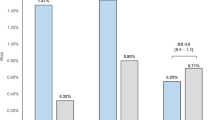Abstract
Benign prostatic hyperplasia (BPH) involves proliferation of smooth muscle cells and increased deposition of extracellular matrix (ECM). We recently found that pentosan polysulfate (PPS) has marked effects on growth and ECM of smooth muscle cells derived from vascular tissues. We examined smooth muscle cells cultured from human prostates and the effects of PPS on their growth and ECM production. Fragments of surgical prostatectomy specimens were diced, digested with collagenase (0.01%), and placed in culture medium supplemented with 20% fetal bovine serum. Outgrowths of elongated cells were characterized by light microscopic examination and immunohistochemical techniques by the presence of F-actin, α-smooth muscle actin, and myosin, which is a characteristic of smooth muscle cells. Two independent isolates were propagated, and growth curves and ECM production were assessed in the presence and absence of PPS (10 or 100 μg/ml). PPS decreased cell number beginning at day 1 and throughout the incubation period, up to 4 days. The amount of the ECM degradative enzymes, metallo-proteinases MMP-9 and MMP-2, was examined by zymography. PPS did not alter the amount of MMP-2 in the supernatants but MMP-9 was increased 234.4±17.23-fold over control cells. Tissue inhibitor of MMP (TIMPS), examined by reverse zymography, increased 200% over control. The amount of αI type (IV) and αI type (I) collagen released in the supernatant, measured by ELISA, significantly decreased in PPS-treated cultures. In conclusion, we found that the administration of PPS decreased proliferation as well as ECM production in prostate smooth muscle. Since smooth muscle proliferation and ECM are involved in the pathophysiology of BPH, PPS may have therapeutic potential.
This is a preview of subscription content, access via your institution
Access options
Subscribe to this journal
Receive 4 print issues and online access
$259.00 per year
only $64.75 per issue
Buy this article
- Purchase on Springer Link
- Instant access to full article PDF
Prices may be subject to local taxes which are calculated during checkout






Similar content being viewed by others
References
Elliot SJ et al. Pentosan polysufate decreases proliferation and net extracellular matrix production in mouse mesangial cells. J Am Soc Nephrol 1999; 10: 62–68.
Elliot SJ et al. Pentosan polysulfate decreases proliferation and extracellular matrix deposition by vascular smooth muscle cells isolated from failed hemodialysis access grafts. Clin Nephrol 2000; 54: 121–127.
Striker GE et al. Glomerulosclerosis, arteriosclerosis, and vascular graft stenosis; treatment with oral heparinoids. Kidney Int 1997; 63: S120–S123.
Tan EML et al. Modulation of extracellular matrix gene expression by heparin and endothelial cell growth factor in human smooth muscle cells. Lab Invest 1991; 64: 474–482.
Lush RM et al. A phase I study of pentosan polysulfate sodium in patients with advanced malignancies. Ann Oncol 1996; 7: 939–944.
Zenjari C et al. Experimental evidence for FGF-1 control of blastema cell proliferation during limb regeneration of the amphibian Pleurodeles waltl. Int J Dev Biol 1996; 40: 965–971.
Kilgore KS et al. The semisynthetic polysaccharide pentosan polysulfate prevents complement-mediated myocardial injury in the rabbit perfused heart. J Pharmacol Exp Ther 1998; 285: 987–994.
Sand PK, Winkler HA . Analysis of long-term Elmiron therapy for interstitial cystitis. Urology 1997; 49(Suppl 5A): 93–99. J Womens Health 1998; 7: 268–269.
Gee WF et al. 1997 American Urological Association Gallup survey: changes in diagnosis and management of prostate cancer and benign prostatic hyperplasia, and other practice trends from 1994 to 1997. J Urol 1998; 160: 1804–1807.
Barry MJ et al. Relationship of symptoms of prostatism to commonly used physiological and anatomical measures of the severity of benign prostatic hyperplasia. J Urol 1993; 150: 351–358.
Moore E et al. Proscar: five-year experience. Eur Urol 1995; 28: 304–309.
Tammela TL et al. Repeated pressure-flow studies in the evaluation of bladder outlet obstruction due to benign prostatic enlargement. Finasteride Urodynamics Study Group. Neurourol Urodyn 1999; 18: 17–24.
Boyle P, Gould AL, Roehrborn CG . Prostate volume predicts outcome of treatment of benign prostatic hyperplasia with finasteride: meta-analysis of randomized clinical trials. Urology 1996; 48: 398–405.
Carraro JC et al. Comparison of phytotherapy (Permixon) with finasteride in the treatment of benign prostate hyperplasia: a randomized international study of 1098 patients. Prostate 1996; 29: 231–240.
Author information
Authors and Affiliations
Corresponding author
Rights and permissions
About this article
Cite this article
Elliot, S., Zorn, B., Mcleod, D. et al. Pentosan polysulfate decreases prostate smooth muscle proliferation and extracellular matrix turnover. Prostate Cancer Prostatic Dis 6, 138–142 (2003). https://doi.org/10.1038/sj.pcan.4500632
Received:
Accepted:
Published:
Issue Date:
DOI: https://doi.org/10.1038/sj.pcan.4500632



